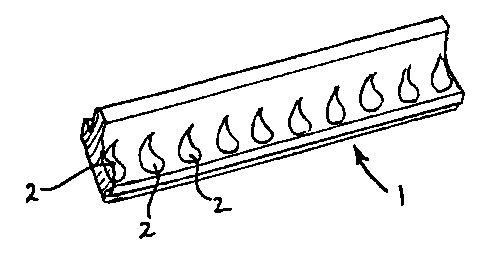Some of the information on this Web page has been provided by external sources. The Government of Canada is not responsible for the accuracy, reliability or currency of the information supplied by external sources. Users wishing to rely upon this information should consult directly with the source of the information. Content provided by external sources is not subject to official languages, privacy and accessibility requirements.
Any discrepancies in the text and image of the Claims and Abstract are due to differing posting times. Text of the Claims and Abstract are posted:
| (12) Patent: | (11) CA 2145561 |
|---|---|
| (54) English Title: | PICTURE FRAMES |
| (54) French Title: | CADRES |
| Status: | Expired and beyond the Period of Reversal |
| (51) International Patent Classification (IPC): |
|
|---|---|
| (72) Inventors : |
|
| (73) Owners : |
|
| (71) Applicants : |
|
| (74) Agent: | AVENTUM IP LAW LLP |
| (74) Associate agent: | |
| (45) Issued: | 2003-02-11 |
| (22) Filed Date: | 1995-03-27 |
| (41) Open to Public Inspection: | 1995-10-27 |
| Examination requested: | 1997-05-27 |
| Availability of licence: | N/A |
| Dedicated to the Public: | N/A |
| (25) Language of filing: | English |
| Patent Cooperation Treaty (PCT): | No |
|---|
| (30) Application Priority Data: | |||||||||
|---|---|---|---|---|---|---|---|---|---|
|
The present invention relates to a process for manufacturing frame members
for picture frames and to the product of that process. The process comprises
the steps of forming a plastics extrusion and cutting it into lengths and
applying to the lengths of plastic extrusion a solvent based wood paste which
is then moulded or otherwise shaped such that it forms ornamentation on the
surface of the plastics extrusion and it is then allowed to dry. This process
makes use of the low cost of extrusion plastics moulding but enables the
ornamental features that would otherwise only be obtainable by injection
moulding to be obtained with the extrusion moulding.
Note: Claims are shown in the official language in which they were submitted.
Note: Descriptions are shown in the official language in which they were submitted.

2024-08-01:As part of the Next Generation Patents (NGP) transition, the Canadian Patents Database (CPD) now contains a more detailed Event History, which replicates the Event Log of our new back-office solution.
Please note that "Inactive:" events refers to events no longer in use in our new back-office solution.
For a clearer understanding of the status of the application/patent presented on this page, the site Disclaimer , as well as the definitions for Patent , Event History , Maintenance Fee and Payment History should be consulted.
| Description | Date |
|---|---|
| Inactive: IPC expired | 2019-01-01 |
| Inactive: Adhoc Request Documented | 2018-06-06 |
| Revocation of Agent Requirements Determined Compliant | 2018-05-18 |
| Appointment of Agent Requirements Determined Compliant | 2018-05-18 |
| Time Limit for Reversal Expired | 2007-03-27 |
| Letter Sent | 2006-03-27 |
| Inactive: IPC from MCD | 2006-03-11 |
| Inactive: IPC from MCD | 2006-03-11 |
| Inactive: IPC from MCD | 2006-03-11 |
| Inactive: IPC from MCD | 2006-03-11 |
| Inactive: Late MF processed | 2005-04-19 |
| Letter Sent | 2005-03-29 |
| Grant by Issuance | 2003-02-11 |
| Inactive: Cover page published | 2003-02-10 |
| Pre-grant | 2002-11-21 |
| Inactive: Final fee received | 2002-11-21 |
| Letter Sent | 2002-05-21 |
| Notice of Allowance is Issued | 2002-05-21 |
| Notice of Allowance is Issued | 2002-05-21 |
| Inactive: Approved for allowance (AFA) | 2002-05-02 |
| Amendment Received - Voluntary Amendment | 1997-09-22 |
| Letter Sent | 1997-06-27 |
| Inactive: Status info is complete as of Log entry date | 1997-06-18 |
| Inactive: Application prosecuted on TS as of Log entry date | 1997-06-18 |
| All Requirements for Examination Determined Compliant | 1997-05-27 |
| Request for Examination Requirements Determined Compliant | 1997-05-27 |
| Application Published (Open to Public Inspection) | 1995-10-27 |
There is no abandonment history.
The last payment was received on 2002-03-27
Note : If the full payment has not been received on or before the date indicated, a further fee may be required which may be one of the following
Please refer to the CIPO Patent Fees web page to see all current fee amounts.
| Fee Type | Anniversary Year | Due Date | Paid Date |
|---|---|---|---|
| Request for examination - standard | 1997-05-27 | ||
| MF (application, 3rd anniv.) - standard | 03 | 1998-03-27 | 1998-01-21 |
| MF (application, 4th anniv.) - standard | 04 | 1999-03-29 | 1999-03-19 |
| MF (application, 5th anniv.) - standard | 05 | 2000-03-27 | 2000-02-01 |
| MF (application, 6th anniv.) - standard | 06 | 2001-03-27 | 2001-03-26 |
| MF (application, 7th anniv.) - standard | 07 | 2002-03-27 | 2002-03-27 |
| Final fee - standard | 2002-11-21 | ||
| MF (patent, 8th anniv.) - standard | 2003-03-27 | 2003-03-21 | |
| MF (patent, 9th anniv.) - standard | 2004-03-29 | 2004-03-26 | |
| MF (patent, 10th anniv.) - standard | 2005-03-29 | 2005-04-19 | |
| Reversal of deemed expiry | 2005-03-29 | 2005-04-19 |
Note: Records showing the ownership history in alphabetical order.
| Current Owners on Record |
|---|
| ROBOBOND LIMITED |
| Past Owners on Record |
|---|
| ROBERT DETENON |